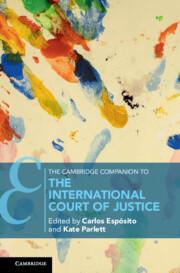Book contents
- The Cambridge Companion to the International Court of Justice
- Cambridge Companions to Law
- The Cambridge Companion to The International Court of Justice
- Copyright page
- Contents
- Contributors
- Preface
- Introduction
- Part I The Role of the ICJ
- Part II The ICJ and International Dispute Settlement
- 6 The Jurisdiction of the Court
- 7 Provisional Measures
- 8 The International Court of Justice as the Master of the Sources
- 9 Fact-Finding and Expert Evidence
- 10 The ICJ and Other Courts and Tribunals: Integration and Fragmentation
- 11 The Working Practices of the Court
- 12 Procedure in Contentious Cases: Evolution and Flexibility
- 13 Effective Advocacy at the ICJ
- Part III The Impact of the ICJ’s Jurisprudence
- Index
- References
11 - The Working Practices of the Court
from Part II - The ICJ and International Dispute Settlement
Published online by Cambridge University Press: 18 May 2023
- The Cambridge Companion to the International Court of Justice
- Cambridge Companions to Law
- The Cambridge Companion to The International Court of Justice
- Copyright page
- Contents
- Contributors
- Preface
- Introduction
- Part I The Role of the ICJ
- Part II The ICJ and International Dispute Settlement
- 6 The Jurisdiction of the Court
- 7 Provisional Measures
- 8 The International Court of Justice as the Master of the Sources
- 9 Fact-Finding and Expert Evidence
- 10 The ICJ and Other Courts and Tribunals: Integration and Fragmentation
- 11 The Working Practices of the Court
- 12 Procedure in Contentious Cases: Evolution and Flexibility
- 13 Effective Advocacy at the ICJ
- Part III The Impact of the ICJ’s Jurisprudence
- Index
- References
Summary
This chapter describes the working practices of the Court, and the reforms made to increase the speed of cases, as well as to improve the processes. The author notes that the Court has demonstrated significant agility in its more recent amendments to the Rules to take account of the worldwide pandemic, and argues that there is evidence to suggest that the Court is becoming more assertive, moving away from its traditionally high level of deference to States.
Keywords
- Type
- Chapter
- Information
- The Cambridge Companion to the International Court of Justice , pp. 223 - 246Publisher: Cambridge University PressPrint publication year: 2023

